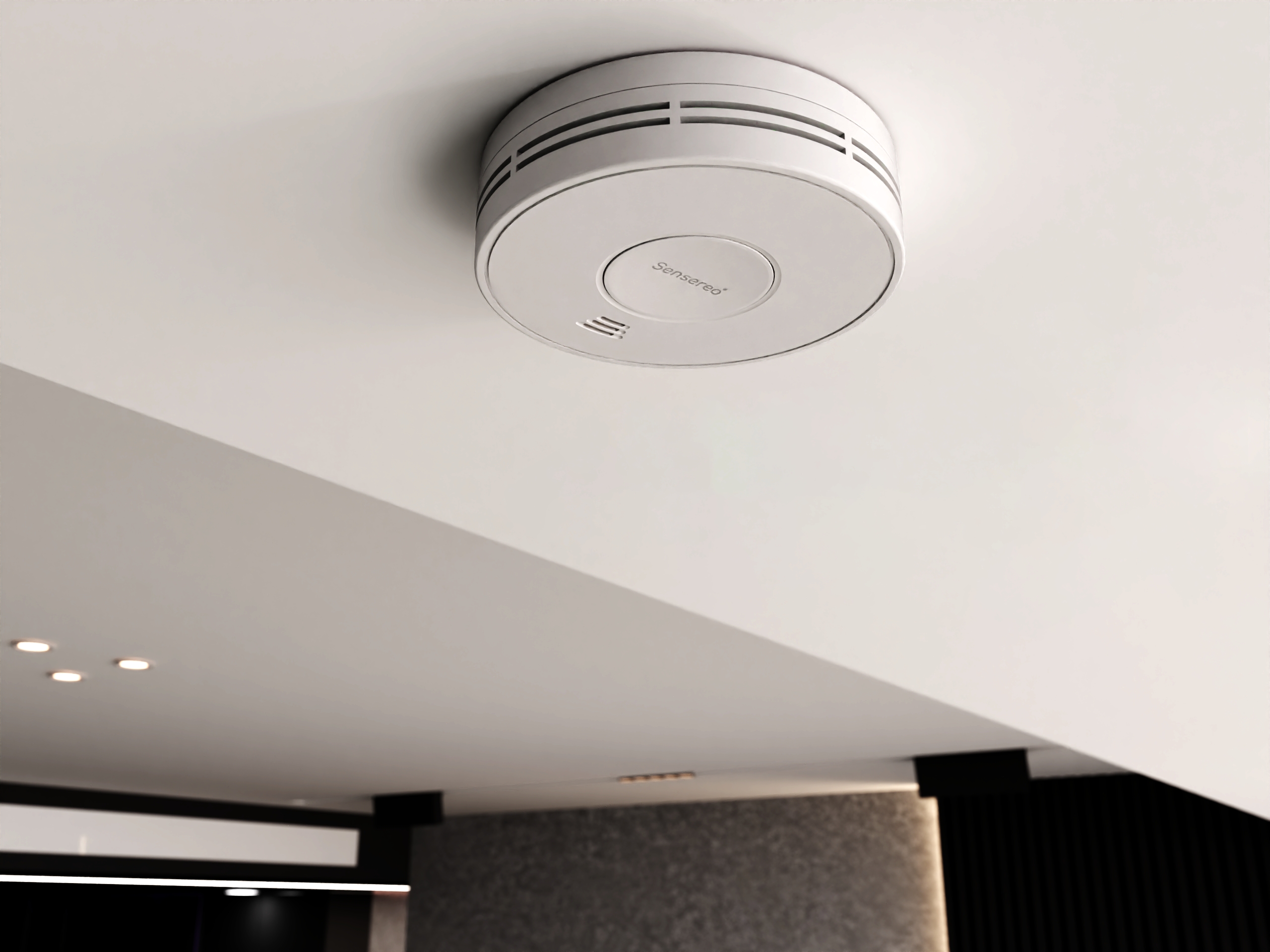Brief Summary:
A smart smoke detector offers a significant upgrade over a traditional alarm by leveraging connectivity and advanced sensors for enhanced safety and convenience. Unlike a traditional alarm that only sounds a local siren, a smart smoke detector sends real-time alerts to your smartphone, even when you’re away from home. Advanced models, particularly those using new standards like Matter over Thread devices, can speak, provide the exact location of a fire, and form a self-healing wireless network that ensures every alarm sounds simultaneously, providing faster, more reliable warnings that can make the difference between a minor incident and a catastrophe.
Smart Smoke Detectors vs. Traditional Alarms
Your home is the place where you and your family should feel safest. But what if your most critical safety device, your smoke alarm is using decades old technology? For years, the traditional, beeping box on the ceiling was the gold standard. Today, a new generation of smart smoke detectors is changing the game, offering features that go far beyond a simple siren. But is the upgrade truly worth the investment?
This comprehensive guide will break down the fundamental differences between smart and traditional alarms, exploring the technology, features, and real-world safety benefits of each. We’ll also delve into the latest innovations, including how the new Matter over Thread standard is making these devices more reliable and easier to use than ever before. By the end, you’ll have all the information you need to decide if a smart home safety system is the right choice for you.
The Foundation: Understanding Traditional Smoke Alarms
Before we can appreciate the “smart” revolution, it’s important to understand the basics. Traditional smoke alarms are either battery-powered or hardwired and operate using one of two primary sensor technologies:
- Ionization Sensors:These are best at detecting fast-flaming fires that produce smaller, less visible smoke particles. They work by using a small amount of radioactive material to ionize the air between two charged plates. When smoke enters the chamber, it disrupts this current, triggering the alarm.
- Photoelectric Sensors:These are more effective at detecting smoldering fires, which produce large, smoky particles. They work by shining a beam of light inside a chamber. When smoke particles enter, they reflect the light onto a sensor, activating the alarm.
While both are effective and save countless lives, they have limitations. They are purely local. Their only function is to sound a loud, piercing siren in a single location. If a fire starts while you’re at work or on vacation, you wouldn’t know until you returned home to find a total loss. They also suffer from the infamous 2 a.m. low-battery chirp, which has led many frustrated homeowners to simply remove the battery.
The Evolution: What Makes a Smoke Detector “Smart”?

A smart smoke detector takes the core function of a traditional alarm and integrates it into your connected home. It combines the fundamental smoke and carbon monoxide (CO) sensing capabilities with a communication module typically Wi-Fi, Zigbee, Z-Wave, or the new Matter over Thread standard to unlock a host of features that provide greater safety, convenience, and peace of mind.
Here’s a breakdown of the key features that set a smart detector apart:
- Real-Time Mobile Alerts:This is arguably the most crucial feature. A smart alarm will instantly send a push notification to your smartphone the moment it detects smoke or CO, regardless of your location. This allows you to call emergency services immediately, giving firefighters precious time to contain the blaze and potentially saving your home from severe damage.
- Voice Alerts and Location Identification:The best smart smoke detectors, such as the Google Nest Protect, replace the jarring siren with a human voice that calmly announces the type of hazard (“Smoke detected”) and its specific location (“in the living room”). This crucial information helps you and your family evacuate safely by guiding you away from the source of the danger.
- Wireless Interconnectivity:A hardwired system ensures that if one alarm goes off, they all do. A smart system achieves this wirelessly. If a Matter smoke detector in the basement senses smoke, it will tell every other compatible alarm in your home to sound the alert and announce the location of the threat. This is especially vital in large homes or multi-level buildings where a single alarm might not be heard throughout the entire house.
- App-Based Control and Monitoring:No more standing on a chair with a broom handle to silence a false alarm caused by burnt toast. The Nest Protect, for example, allows you to silence the alarm directly from its app. The app also provides status updates, runs automatic self-checks, and sends alerts when it’s time to replace the unit or its battery, eliminating the dreaded low-battery chirp.
A Deeper Look at the Technology: The Rise of Matter over Thread Devices
For years, the smart home market was fragmented. A Wi-Fi-based smart alarm from one brand might not talk to a Z-Wave hub from another. This changed with the introduction of Matter, a universal standard that acts as a common language for smart devices.
When this standard is paired with Thread, a low-power, mesh-based wireless protocol, it creates a powerful and reliable network for devices like smoke alarms. A Matter smoke detector is a perfect example of a Matter over Thread device because it benefits from Thread’s unique advantages:
Exceptional Reliability: Thread devices form a self-healing mesh network. Every mains-powered Thread device, such as a smart plug or light bulb, acts as a repeater, extending the network’s range and ensuring there are multiple communication paths. If one device goes offline, the others automatically reroute, making the network incredibly robust a non-negotiable feature for a life-safety device.
Low Power Consumption: This allows battery-powered Matter over Thread devices to operate for years without needing a battery change. Many of the best smart smoke detector models come with sealed, non-replaceable 7-year batteries meaning the device will last its entire useful life without you ever having to worry about battery replacement. Sensereo’s MS-1 is a good option with 7-year lifespan and matching 7-year warranty.
Seamless Cross-Platform Compatibility: The beauty of Matter is its interoperability. A single Matter smoke detector can be added to your Google Home, Apple HomeKit, or Amazon Alexa ecosystem without the need for a separate hub or app, simplifying your smart home setup and giving you the flexibility to mix and match devices from different brands.
Comprehensive Comparison: Smart vs. Traditional
Here is a side-by-side comparison of the two types of alarms across critical safety and usability metrics.
| Feature | Traditional Smoke Alarms | Smart Smoke Detectors |
| Alerts | Loud, local siren only. | Local siren + voice alerts + real-time smartphone notifications. |
| Remote Safety | None. You must be home to hear the alarm. | Full awareness and control from anywhere in the world. |
| Interconnectivity | Hardwired or standalone. No communication between units unless hardwired together. | Wireless mesh network. All compatible alarms sound simultaneously and identify the location of the fire. |
| Convenience | Manual testing, manual battery replacement, and often false alarms from cooking. | App-based testing, automatic low-battery alerts, and app-silence for false alarms. |
| Detection | Single or dual-sensor models. | Many models include dual smoke/CO sensors, and some have additional air quality monitors. |
| Installation | Battery-powered are simple. Hardwired require an electrician. | Generally simple and battery-powered, though some hardwired options exist. |
| Cost | Low initial cost (under $20). | Higher initial cost ($50 – $150+ per unit), but provides greater value. |
Our Top Picks: Finding the Best Smart Smoke Detector for Your Home
While the market for smart smoke detectors is growing, few products embody the full promise of a future-proof safety system as well as the sensereo MS-1. Instead of simply offering a connected version of an old alarm, the MS-1 is purpose-built to leverage the latest in smart home technology, making it our choice for the best smart smoke detector for a modern home.
The sensereo MS-1 stands out by fully embracing the Matter over Thread standard. As a true matter smoke detector, it is designed from the ground up to be seamlessly compatible with every major smart home ecosystem, including Apple HomeKit, Google Home and Samsung SmartThings. This means you’re not locked into a single brand you get the freedom to choose your platform without compromising on safety.
The device features a dual-battery design, which is a significant advantage over many competitors. A sealed, non-replaceable battery powers the core smoke detection sensor for its entire 7-year lifespan. A separate, user-replaceable CR123A battery powers the Matter over Thread communication module, ensuring that the smart features never compromise the fundamental safety function of the device.
For anyone looking to fully upgrade their home safety system with a device that provides not just peace of mind but also the latest in connectivity and reliability, the Sensereo MS-1 is an unparalleled choice.
The Verdict: Is the Upgrade Worth It?
The simple answer is yes. While traditional smoke alarms are a vital first line of defense, they are fundamentally limited. A smart smoke detector isn’t just a gadget. It’s a critical safety upgrade that provides a new level of protection for you and your family. The peace of mind that comes from knowing you will receive an immediate alert, no matter where you are, is invaluable.
By choosing a modern, interconnected system especially a new matter smoke detector that leverages the power of Thread you’re not just buying an alarm you’re investing in a sophisticated, reliable, and intelligent safety network that will actively help you protect what matters most.
FAQs
Q: Do I need a smart home hub to use a smart smoke detector?
A: It depends on the protocol. Wi-Fi-based models usually connect directly to your home network. However, devices using Zigbee or Z-Wave require a compatible hub. A Matter over Thread smoke detector can often connect directly to a Thread Border Router built into your smart home ecosystem (like a HomePod mini or Google Nest Hub), simplifying the setup.
Q: How does a smart smoke detector handle false alarms?
A: Unlike a traditional alarm that you have to manually silence, many smart detectors allow you to hush the alarm directly from their mobile app. Some models also have advanced sensing technology that can differentiate between cooking smoke and an actual fire, significantly reducing false alarms.
Q: Are some products connected to the power source and using the battery as backup? Are they wired or battery powered?
A: As of July 2025, all current Sensereo detectors are battery-powered and do not require wiring. Our MS-1 smoke alarm, for example, uses a dual-battery system: a built-in 7-year battery for core smoke detection and a replaceable CR123A battery (2–3 years lifespan) for powering the Matter over Thread communication module. This ensures continued core safety functionality even if the communication battery runs out.




